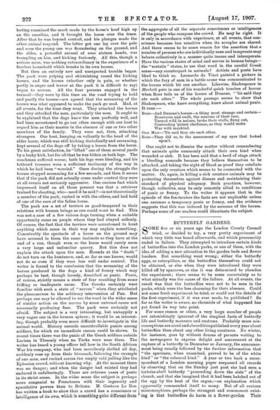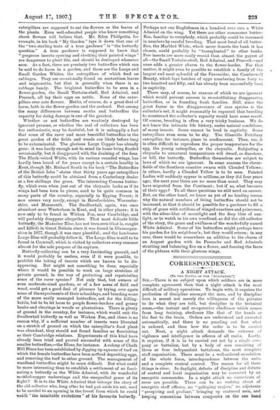BUTTERFLY GARDENS.
SOME five or six years ago the London County Council tried, or decided to try, a very pretty experiment of which very little was heard afterwards, and which presumably ended in failure. They attempted to introduce certain kinds of butterflies into the London parks, or one of them, with the idea of adding a new attraction to the garden beds and flower borders. But something went wrong; either the butterfly eggs, or caterpillars, or the butterflies themselves could not be obtained, or else when they were introduced they were killed off by sparrows, or else it was determined to abandon the experiment; there seems to be some uncertainty as to what actually was the cause of the failure. At all events, the result was that the butterflies were not to be seen in the parks, which were the less charming for their absence. Could not some fresh experiment be tried, or could not the details of the first experiment, if it was ever made, be published ? So far as the writer is aware, no chronicle of what happened has yet found its way into print.
For some reason or other, a very large number of people are astonishingly ignorant of the simplest facts of butterfly life and butterfly manners and customs. Probably more mis- conceptions are aired and absurdities published every year about butterflies than about any other living creatures. No winter, for instance, goes by without dozens of persons writing to the newspapers to express delight and amazement at the capture of a butterfly in December or January, the announce- ment being usually followed by the further information that "the specimen, when examined, proved to be of the white kind" or "the coloured kind." A year or two back a corre- spondent of a London morning paper surpassed all records by observing that on the Sunday just past she had seen a tortoise-shell butterfly "proceeding down the aisle" of the church, and that she imagined that it had been hatched out of the egg by the heat of the organ,—an explanation which apparently commended itself to many. But of all curious misconceptions, perhaps the strangest and commonest exist- ing is that butterflies do harm in a flower-garden. Their
caterpillars are supposed to eat the flowers or the leaves of the plants. • Even well-educated people who know something about flowers will believe that. Mr. Eden Phillpotts, for example, in his book " My Garden" lays it down that one of the "two sterling tests of a true gardener" is " the butterfly question." A true gardener is supposed to know that " gorgeous insects opening and shutting their painted wings " are dangerous to plant life, and should be destroyed whenever seen. As a fact, there are precisely two butterflies which can be said to do harm in a garden, and those are the Large and Small Garden Whites, the caterpillars of which feed on cabbages. They are occasionally found on nasturtium leaves and mignonette, but that is generally when there is no cabbage handy. The. brightest butterflies to be seen in a flower-garden, the Small Tortoise-shell, Red Admiral, and Peacock, all lay their eggs on nettle. None of the cater- pillars ever eats flowers. Moths, of course, do a great deal of harm, both in the flower-garden and the orchard. But among the many . differences between moths and butterflies the capacity for doing damage is one of the greatest.
Whether or not butterflies are wantonly destroyed by ignorant persons, or whether the zeal of collectors has been too enthusiastic, may be doubtful, but it is unhappily a fact that some of the rarer and more beautiful butterflies in the great garden of the fields and woods are likely before long to be.exterminated. The glorious Large Copper has already gone: it was hardy enough not to mind its home being flooded occasionally, but it disappeared with the draining of the fens. The Black-veined White, with its curious rounded wings, has hardly been heard of for years except in a certain locality in . Kent, though Mr. Richard South in his book." The Butterflies of the British Isles" states that thirty years ago caterpillars of this butterfly could be obtained from a Canterbury dealer at a few shillings the gross. The interesting Comma butter- fly, which even when just out of the chrysalis looks as if its wings had been torn to pieces, used to be quite common in ,many parts of the country, especially in Epping Forest; it now occurs very rarely, except in Herefordshire, Worcester- shire, and Monmouth. The Swallowtail, again, . was once abundant near Westerham in Kent, and in other places ; it is now only to be found in Wicken Fen, near Cambridge, and will probably disappear altogether. That most delicate little butterfly, the Mazarine Blue, has not been seen (that is, caught and killed) in Great Britain since it was found in Glamorgan- `shire in 1877, though it was once plentiful; and the handsome Large Blue will probably follow it. The Large Blue is still to be Jound in Cornwall, which is visited by collectors every summer almost for the sole purpose of its capture.
Butterfly-collecting can be a very fascinating pursuit, and it would probably be useless, even if it were possible, to prohibit the taking of insects which are known to be dis- appearing. But might not something be done, especially where it would be possible to work on large stretches of private ground, in the way of protecting and repatriating some of the rarer species ? Not only that, but owners of even moderate-sized gardens, or of a few acres of field and wood, could get a good deal of pleasure by trying over again some of the experiments of their schooldays, and breeding some of the more easily managed butterflies, not for the killing- bottle, but to be let loose to people flower-borders and grassy banks and clearings in woods or plantations. There is plenty of ground in the country, for instance, which would suit the Swallowtail butterfly as well as Wicken Fen, and there is no reason why, if a sufficient number of insects were liberated on a stretch of ground on which the caterpillar's food plant was abundant, they should not found families as flourishing as their Cambridge relations. Experiments of this kind have already been tried and proved successful with some of the smaller butterflies,—the Blues, for instance. A colony of Chalk Hill Blues has been established by digging up squares of turf on which the female butterflies have been noticed depositing eggs, and removing the turf to other ground. The management of woodland butterflies might be more diffieult. But what could be more interesting than to establish a settlement of so fasci- nating a butterfly as the Wbite Admiral, with its wonderful mottled-copper underwings and the -unequalled grace of its flight ? It is to the White Admiral that belongs the story of the old collector who, long after he had put aside his net, used
to be carried to an opening in the forest from which he could wat& " the inimitable evolutions" of his favourite butterfly.
Perhaps not one Englishman in a hundred ever sees a White Admiral on the wing. Yet there are other commoner butter- flies, familiar to everybody, which probably could be increased in numbers by careful breeding. That most local of all butter- flies, the Marbled White, which never deserts the bank it has chosen, could probably be "transplanted" to other banks. Few insects are more easily reared than almost the gayest of all—the Small Tortoise-shell, Red Admiral, and Peacock—and none adds a greater charm to the flower-border. For that matter, it might even be possible to establish a family of the largest and most splendid of the Vanessidae, the Camberwell Beauty, which lays batches of eggs numbering from forty to two hundred and fifty, and has already been successfully bred in captivity.
There may, of course, be reasons of which we are ignorant which would prevent success in re-establishing disappearing butterflies, or in founding fresh families. Still, since the great factor in the disappearance of rare species is the collector's net, it might reasonably be expected that breeding to counteract the collector's rapacity would have some result. Of course, breeding is often a very tricky business. We do not know the intimate life history, under natural conditions, of many insects. Some cannot be bred in captivity. Some caterpillars even seem to be shy. The Glanville Fritillary caterpillar, for instance, pines in confinement. Then, too, it is often difficult to reproduce the proper temperature for the egg, the young caterpillar, or the chrysalis. Subjecting a chrysalis to unnatural temperatures will dwarf, or discolour, or kill, the butterfly. Butterflies themselves are subject to laws of which we are ignorant. In some seasons the clover- fields of the Southern counties swarm with Clouded Yellows ; in others, hardly a Clouded Yellow is to be seen. Painted Ladies will suddenly appear in millions, as they did four years ago; the next year there are no more than usual. They may have migrated from the Continent ; but if so, what becomes of their eggs? To all these questions we still need an answer. But, on the other hand, we know as yet of no binding reason why the natural numbers of living butterflies should not be increased, so that it should be possible for a gardener to fill a strip of grass with cotillons of winged courtiers and princesses, with the silver-blue of moonlight and the deep blue of sun- light, or to watch in his own woodland, as did the old collector of the story, the grace and swiftness of the wonderfully named White Admiral. Some of his butterflies might perhaps leave his garden for his neighbour's; but they would return; in any case, there would be somewhere an addition to the charm of an August garden with its Peacocks and Red Admirals strutting and balancing five on a flower, and fanning the faces of the phloxes with their glorious wings.



































 Previous page
Previous page